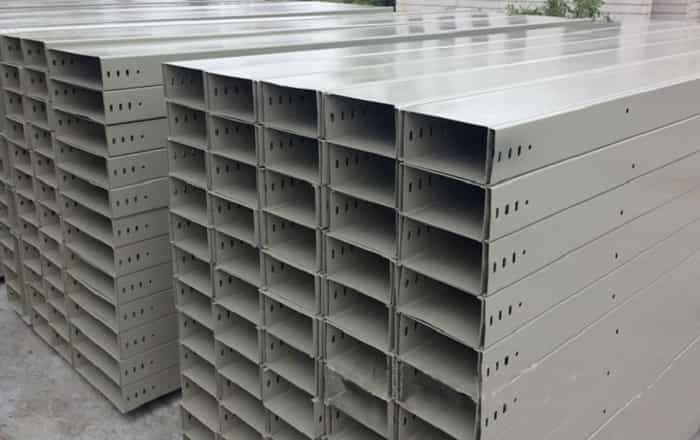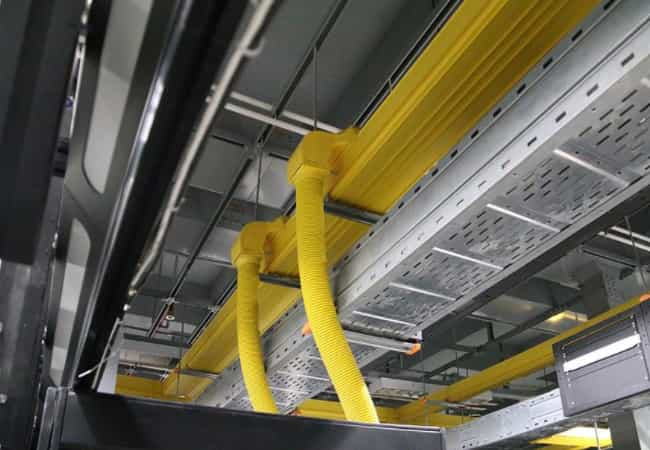কেবল পরিচালনা আধুনিক অবকাঠামোর একটি গুরুত্বপূর্ণ দিক, বৈদ্যুতিক তারগুলি সংগঠিত হয়েছে তা নিশ্চিত করে, অ্যাক্সেসযোগ্য, এবং সুরক্ষিত. উপলব্ধ অনেক সমাধান মধ্যে, কেবল ট্রে তাদের বহুমুখিতা এবং দক্ষতার জন্য দাঁড়িয়ে. এই বিস্তৃত গাইডটি কেবল ট্রে সম্পর্কে আপনার যা জানা দরকার তা আবিষ্কার করে, বিভিন্ন ধরণের সহ, আকার বিবেচনা, এবং শিল্পে শীর্ষ কেবল ট্রে উত্পাদনকারী এবং সরবরাহকারী.

1. কেবল ট্রে কি?
তারের ট্রেগুলি বৈদ্যুতিক সিস্টেমে অবিচ্ছেদ্য উপাদান, অন্তরক বৈদ্যুতিক তারগুলি সমর্থন করতে ব্যবহৃত. তারা তারের জন্য একটি কাঠামোগত পথ সরবরাহ করে, ইনস্টলেশন সুবিধার্থে, রক্ষণাবেক্ষণ, এবং পরিবর্তন. কেবল ট্রে কেবলগুলি সংগঠিত করতে এবং তারা শারীরিক ক্ষতি এবং পরিবেশগত কারণগুলি থেকে নিরাপদে সুরক্ষিত রয়েছে তা নিশ্চিত করতে সহায়তা করুন.
2. কেবল ট্রে প্রকার
বিভিন্ন ধরণের কেবল ট্রে রয়েছে, প্রতিটি নির্দিষ্ট প্রয়োজন মেটাতে ডিজাইন করা:
2.1. মই তারের ট্রে
মই তারের ট্রে, কেবল মই হিসাবে পরিচিত, অনুভূমিক রঞ্জের সাথে একটি মইয়ের সাথে সাদৃশ্যপূর্ণ. এগুলি পরিবেশের জন্য আদর্শ যেখানে বায়ুচলাচল প্রয়োজনীয়, এবং এগুলি প্রায়শই ভারী শুল্ক অ্যাপ্লিকেশনগুলির জন্য ব্যবহৃত হয়. ওপেন ডিজাইনটি কেবলগুলির সহজে অ্যাক্সেস এবং শীতল করার অনুমতি দেয়.
2.2. ছিদ্রযুক্ত কেবল ট্রে
ছিদ্রযুক্ত তারের ট্রেগুলি মই ট্রেগুলির মতো তবে পারফোরেশন সহ একটি শক্ত বেস বৈশিষ্ট্যযুক্ত. এই নকশাটি ছোট তারগুলি সমর্থন করে এবং বায়ুচলাচল করার অনুমতি দেওয়ার সময় মাঝারি সুরক্ষা সরবরাহ করে.
2.3. সলিড নীচের তারের ট্রে
সলিড বটম ক্যাবল ট্রেগুলি কেবল সমর্থনের জন্য একটি অবিচ্ছিন্ন শক্ত পৃষ্ঠ সরবরাহ করে, ধুলো যেখানে পরিবেশের জন্য তাদের উপযুক্ত করে তুলছে, ধ্বংসাবশেষ, বা অন্যান্য দূষকগুলি উদ্বেগ হতে পারে. তারা দুর্দান্ত সুরক্ষা সরবরাহ করে এবং প্রায়শই শিল্প সেটিংসে ব্যবহৃত হয়.
2.4. তারের জাল কেবল ট্রে
তারের জাল কেবলের ট্রেগুলি বোনা বা ld ালাই ধাতু জাল দিয়ে তৈরি. এগুলি হালকা ওজনের এবং কেবল রাউটিংয়ে নমনীয়তা সরবরাহ করে. এই ট্রেগুলি প্রায়শই অ্যাপ্লিকেশনগুলিতে ব্যবহৃত হয় যেখানে সহজ পরিবর্তনগুলি প্রয়োজন.
2.5. কেবল ট্রাঙ্কিং
কেবল ট্রাঙ্কিং, কখনও কখনও কেবল নালী হিসাবে উল্লেখ করা হয়, এক ধরণের কেবল পরিচালনা ব্যবস্থা যা কেবলগুলি কভার করে এবং সুরক্ষা দেয়. এটি সাধারণত এমন অঞ্চলে ব্যবহৃত হয় যেখানে নান্দনিকতা উদ্বেগ বা যেখানে কেবলগুলি গোপন করা দরকার.
3. কেবল ট্রে ব্যবহারের মূল সুবিধা
কেবল ট্রে বৈদ্যুতিক সিস্টেম পরিচালনার জন্য অসংখ্য সুবিধা দেয়:
বর্ধিত কেবল সুরক্ষা: তারা তারগুলি শারীরিক ক্ষতি এবং পরিবেশগত কারণগুলি থেকে রক্ষা করে.
উন্নত সুরক্ষা: কেবলগুলি সংগঠিত করে, তারা ট্রিপিং ঝুঁকি এবং সম্ভাব্য আগুনের ঝুঁকি হ্রাস করে.
রক্ষণাবেক্ষণের স্বাচ্ছন্দ্য: কেবল ট্রেগুলি পরিদর্শন এবং রক্ষণাবেক্ষণের জন্য সহজ অ্যাক্সেসের সুবিধার্থে.
নমনীয়তা: তারা সহজ পরিবর্তন এবং বৈদ্যুতিক সিস্টেমগুলির বিস্তারের অনুমতি দেয়.
ব্যয়-কার্যকারিতা: তারা প্রায়শই বিকল্প কেবল পরিচালনা সিস্টেমের তুলনায় আরও অর্থনৈতিক সমাধান হিসাবে প্রমাণিত হয়.
4. কেবল ট্রে সাইজিং এবং ইনস্টলেশন
তারের ট্রেগুলির কার্যকর পারফরম্যান্সের জন্য যথাযথ আকার এবং ইনস্টলেশন গুরুত্বপূর্ণ:
4.1. আকার নির্ধারণ
কেবল ট্রে নির্বাচন করার সময়, এটি বিবেচনা করা অপরিহার্য:
তারের পরিমাণ এবং আকার: ট্রে অবশ্যই তারের সংখ্যা এবং আকারকে সামঞ্জস্য করতে হবে.
লোড বহন ক্ষমতা: ট্রে তারের ওজন এবং যে কোনও অতিরিক্ত লোড পরিচালনা করতে পারে তা নিশ্চিত করুন.
পরিবেশগত পরিস্থিতি: তাপমাত্রার মতো কারণগুলি বিবেচনা করুন, আর্দ্রতা, এবং রাসায়নিক বা ক্ষয়কারী উপাদানগুলির এক্সপোজার.
4.2. ইনস্টলেশন নির্দেশিকা
যথাযথ ইনস্টলেশন অনুশীলন অন্তর্ভুক্ত:
সুরক্ষিত ট্রে: নিশ্চিত করুন যে ট্রেগুলি সুরক্ষিত বা চলাচল প্রতিরোধের জন্য সুরক্ষিতভাবে মাউন্ট করা হয়েছে.
পর্যাপ্ত জায়গা বজায় রাখা: কুলিং এবং রক্ষণাবেক্ষণের জন্য কেবলগুলির চারপাশে পর্যাপ্ত জায়গার অনুমতি দিন.
নিম্নলিখিত বিধিবিধান: ইনস্টলেশন চলাকালীন স্থানীয় বৈদ্যুতিক কোড এবং মানগুলি মেনে চলুন.

5. ডান কেবল ট্রে প্রস্তুতকারক নির্বাচন করা
একটি নির্ভরযোগ্য কেবল ট্রে প্রস্তুতকারক নির্বাচন করা গুণমান এবং কার্যকারিতা নিশ্চিত করার জন্য গুরুত্বপূর্ণ. এখানে কিছু কারণ বিবেচনা করা উচিত:
5.1. খ্যাতি এবং অভিজ্ঞতা
শিল্পে একটি শক্তিশালী খ্যাতি এবং বিস্তৃত অভিজ্ঞতা সহ নির্মাতাদের সন্ধান করুন. প্রতিষ্ঠিত নির্মাতারা উচ্চমানের পণ্য এবং নির্ভরযোগ্য সহায়তা সরবরাহ করার সম্ভাবনা বেশি.
5.2. পণ্য পরিসীমা
বিস্তৃত কেবল ট্রে এবং সম্পর্কিত পণ্য সরবরাহকারী একটি নির্মাতা বিভিন্ন প্রয়োজন এবং পছন্দগুলি আরও ভালভাবে পূরণ করতে পারেন. নিশ্চিত করুন যে তারা আপনার প্রয়োজনীয় নির্দিষ্ট ধরণের ট্রে সরবরাহ করে.
5.3. কাস্টমাইজেশন বিকল্প
অনন্য অ্যাপ্লিকেশন জন্য, কাস্টমাইজেশন প্রয়োজনীয় হতে পারে. আপনার নির্দিষ্ট প্রয়োজনীয়তাগুলি পূরণের জন্য কাস্টম সমাধান সরবরাহ করে এমন একটি প্রস্তুতকারক চয়ন করুন.
5.4. গুণগত নিশ্চয়তা
যাচাইকারী শিল্পের মান এবং গুণগত নিশ্চয়তা প্রক্রিয়াগুলি মেনে চলে তা যাচাই করুন. এটি নিশ্চিত করে যে ট্রেগুলি টেকসই এবং প্রত্যাশার মতো সম্পাদন করে.
একটি কেবল ট্রে সরবরাহকারী হিসাবে, ডসেন্স কেবল কেবল পণ্যগুলি নয়, নির্দিষ্ট প্রকল্পের প্রয়োজনীয়তার সাথে উপযুক্তভাবে বৈদ্যুতিক কেবল পরিচালন সিস্টেমগুলি সরবরাহ করার জন্য নিজেকে গর্বিত করে. আমাদের কেবল ট্রেগুলি সবচেয়ে কঠিন শর্তগুলি সহ্য করার জন্য ডিজাইন করা হয়েছে, এমনকি সবচেয়ে চ্যালেঞ্জিং পরিবেশে নিরাপদ এবং দক্ষ কেবল রাউটিং নিশ্চিত করা. শিল্প কারখানা থেকে বাণিজ্যিক কমপ্লেক্স পর্যন্ত, হাসপাতাল, এবং ডেটা সেন্টার, নির্ভরযোগ্যতা এবং স্থায়িত্ব সহ সমালোচনামূলক অবকাঠামোকে সমর্থন করার জন্য আমাদের কেবল ট্রেগুলি বিশ্বস্ত.
Traditional তিহ্যবাহী তারের ট্রে ছাড়িয়ে আমাদের দক্ষতা বাড়ানো, ডসেন্স কেবলটিও একটি শীর্ষস্থানীয় কেবল মই সরবরাহকারী এবং প্রস্তুতকারক. তারের মই, তাদের ওপেন-ফ্রেম ডিজাইনের জন্য পরিচিত, ব্যতিক্রমী বায়ুচলাচল এবং অ্যাক্সেসযোগ্যতা অফার করুন, তাদের অ্যাপ্লিকেশনগুলির জন্য আদর্শ করে তোলা যেখানে তাপ অপচয় এবং সহজ রক্ষণাবেক্ষণ অত্যন্ত গুরুত্বপূর্ণ. আমাদের মই প্রকারের কেবল ট্রেগুলি নির্ভুলতার সাথে তৈরি করা হয়, দীর্ঘমেয়াদী কর্মক্ষমতা এবং স্থায়িত্ব নিশ্চিত করে এমন উচ্চ-মানের উপকরণ ব্যবহার করে. এটি কোনও নতুন ইনস্টলেশন বা একটি retrofit প্রকল্প হোক, আমাদের কেবল মই সমাধানগুলি কেবল পরিচালনা এবং স্থান ব্যবহারের অনুকূলকরণের জন্য ডিজাইন করা হয়েছে.
6.কেবল ট্রে সিস্টেমের জন্য ডিজাইন বিবেচনা
একটি কেবল ট্রে সিস্টেম ডিজাইন করার সময়, এর কার্যকারিতা নিশ্চিত করতে বেশ কয়েকটি বিষয় অবশ্যই বিবেচনায় নিতে হবে, সুরক্ষা, এবং ব্যয়-কার্যকারিতা.
6.1 লোড ক্ষমতা
প্রথম এবং সর্বাগ্রে বিবেচনা হ'ল ট্রেয়ের লোড ক্ষমতা. এটি অবশ্যই কেবলগুলির ওজন সমর্থন করতে সক্ষম হতে হবে, তারের সংখ্যা বিবেচনায় নেওয়া, তাদের ব্যাস, এবং কোনও অতিরিক্ত আনুষাঙ্গিক যেমন ফাস্টেনার বা বন্ধনী.
6.2 উপাদান নির্বাচন:
বিভিন্ন উপকরণ থেকে কেবল ট্রে তৈরি করা যেতে পারে, ইস্পাত সহ, অ্যালুমিনিয়াম, স্টেইনলেস স্টিল, এবং ফাইবারগ্লাস-চাঙ্গা প্লাস্টিক (এফআরপি). পছন্দটি অ্যাপ্লিকেশনটির নির্দিষ্ট প্রয়োজনীয়তার উপর নির্ভর করে, যেমন জারা প্রতিরোধের, ওজন, এবং ব্যয়.
6.3 পরিবেশগত পরিস্থিতি:
ট্রে এর উপাদান এবং নকশা অবশ্যই এটি পরিবেশগত অবস্থার সাথে প্রতিরোধ করা উচিত, তাপমাত্রা সহ, আর্দ্রতা, এবং রাসায়নিক বা ক্ষয়কারী উপাদানগুলির এক্সপোজার.
6.4 আগুন সুরক্ষা
অনেক অ্যাপ্লিকেশন, বিশেষত শিল্প সেটিংসে যারা, আগুন সুরক্ষা একটি গুরুত্বপূর্ণ উদ্বেগ. আগুন-প্রতিরোধী উপকরণ থেকে তৈরি কেবল ট্রে বা ফায়ার-স্টপিং ডিভাইস দিয়ে সজ্জিত আগুনের বিস্তার হ্রাস করতে সহায়তা করতে পারে.
6.5 অ্যাক্সেসযোগ্যতা এবং রক্ষণাবেক্ষণযোগ্যতা:
ট্রে ডিজাইনের রক্ষণাবেক্ষণের জন্য কেবলগুলিতে সহজে অ্যাক্সেসের সুবিধার্থে হওয়া উচিত, মেরামত, বা আপগ্রেড. রঞ্জের মধ্যে ব্যবধান হিসাবে বিবেচনা, ট্রে প্রস্থ, এবং অ্যাক্সেস প্যানেলগুলির অন্তর্ভুক্তি রক্ষণাবেক্ষণের দক্ষতাকে উল্লেখযোগ্যভাবে প্রভাবিত করতে পারে.
6.6 মান এবং নিয়মকানুনের সাথে সম্মতি:
কেবল ট্রে সিস্টেমগুলি অবশ্যই প্রাসঙ্গিক আন্তর্জাতিক এবং স্থানীয় মান এবং নিয়ম মেনে চলতে হবে, বৈদ্যুতিক সুরক্ষার সাথে সম্পর্কিতগুলি সহ, আগুন সুরক্ষা, এবং পরিবেশগত বিবেচনা.
7. ইনস্টলেশন পদ্ধতি
কেবল ট্রে ইনস্টলেশন বিভিন্ন পদক্ষেপ জড়িত, সুরক্ষা মান এবং সিস্টেমের উদ্দেশ্যযুক্ত উদ্দেশ্যগুলির সাথে সম্মতি নিশ্চিত করা. কেবল ট্রে ইনস্টলেশন এর মূল দিকগুলি এখানে:
7.1 সাইট প্রস্তুতি:
সাইটের শর্তগুলি মূল্যায়ন করে শুরু করুন, পৃষ্ঠের ধরণ সহ (যেমন, কংক্রিট, ধাতব ডেকিং), পরিবেশগত কারণগুলি (যেমন, তাপমাত্রা, আর্দ্রতা), এবং অ্যাক্সেসযোগ্যতা.
নিশ্চিত করুন যে অঞ্চলটি বাধা থেকে পরিষ্কার এবং প্রয়োজনীয় সরঞ্জাম এবং সরঞ্জাম প্রস্তুত করুন.
7.2 ডিজাইন এবং লেআউট:
একটি বিশদ নকশা পরিকল্পনা বিকাশ, তারের রুট বিবেচনা করে, প্রয়োজনীয় ট্রেগুলির সংখ্যা এবং আকার, এবং সমর্থনগুলির লোড বহন ক্ষমতা.
মেঝে বা দেয়ালে সমর্থন এবং ট্রেগুলির অবস্থানগুলি চিহ্নিত করুন, একটি লেজার স্তর বা অন্যান্য নির্ভুল সরঞ্জাম ব্যবহার করে.
7.3 সমর্থন ইনস্টলেশন:
সমর্থন ইনস্টল করুন (বা বন্ধনী) চিহ্নিত অবস্থানে, এগুলি নিশ্চিত করে যে তারা কাঠামোতে নিরাপদে দৃ ten ়ভাবে বেঁধে দেওয়া হয়েছে.
সমর্থনগুলির প্রান্তিককরণ এবং স্তর পরীক্ষা করুন, একটি মসৃণ এবং স্তর ট্রে রান নিশ্চিত করতে প্রয়োজনীয় হিসাবে সামঞ্জস্য করা.
7.4 ট্রে ইনস্টলেশন:
প্রস্তুতকারকের নির্দেশাবলী অনুসারে কেবল ট্রেগুলি একত্রিত করুন, উপযুক্ত ফাস্টেনারগুলির সাথে তাদের শেষ থেকে শেষের সাথে সংযুক্ত করা.
সমর্থনগুলিতে ট্রে রাখুন, তারা সঠিকভাবে সারিবদ্ধ এবং স্তর রয়েছে তা নিশ্চিত করে.
উপযুক্ত হার্ডওয়্যার ব্যবহার করে সমর্থনগুলিতে ট্রেগুলি বেঁধে দিন, যেমন বোল্ট বা ক্লিপ.
7.5 কেবল ইনস্টলেশন:
সাবধানতার সাথে ট্রেগুলির মাধ্যমে কেবলগুলি এবং তারগুলি রুট করুন, নকশা পরিকল্পনা অনুসরণ এবং তারা সঠিকভাবে সমর্থিত এবং সংগঠিত হয়েছে তা নিশ্চিত করে.
ট্রেগুলির মধ্যে কেবলগুলি সুরক্ষিত করতে কেবলের সম্পর্ক বা অন্যান্য ফাস্টেনার ব্যবহার করুন, যথাযথ ব্যবধান বজায় রাখা এবং উপচে পড়া ভিড় এড়ানো.
7.6 পরিদর্শন এবং পরীক্ষা:
ইনস্টল করা কেবল ট্রে সিস্টেমের একটি সম্পূর্ণ পরিদর্শন করুন, যে কোনও ত্রুটি পরীক্ষা করা হচ্ছে, আলগা সংযোগ, বা ডিজাইন পরিকল্পনার সাথে সম্মতি.
এটি প্রয়োজনীয় লোড-ভারবহন ক্ষমতা এবং কার্যকারিতা পূরণ করে তা নিশ্চিত করার জন্য সিস্টেমটি পরীক্ষা করুন.
8. স্টেইনলেস স্টিল কেবল ট্রে বনাম পিভিসি কেবল ট্রে
যখন এটি কেবল পরিচালনা সিস্টেমে আসে, সর্বাধিক জনপ্রিয় দুটি বিকল্প হ'ল স্টেইনলেস স্টিল কেবল ট্রে এবং পিভিসি (পলিভিনাইল ক্লোরাইড) কেবল ট্রে. প্রত্যেকেরই এর সুবিধার অনন্য সেট রয়েছে এবং এটি বিভিন্ন অ্যাপ্লিকেশনগুলির জন্য উপযুক্ত. আপনাকে একটি অবগত সিদ্ধান্ত নিতে সহায়তা করার জন্য এই দুটি ধরণের কেবল ট্রেগুলির একটি বিস্তৃত তুলনা এখানে.
8.1 স্থায়িত্ব এবং শক্তি
স্টেইনলেস স্টিলের কেবল ট্রেগুলি তাদের ব্যতিক্রমী স্থায়িত্ব এবং শক্তির জন্য বিখ্যাত. জারা-প্রতিরোধী স্টেইনলেস স্টিল থেকে তৈরি, তারা কঠোর পরিবেশগত পরিস্থিতি সহ্য করতে পারে, চরম তাপমাত্রা সহ, আর্দ্রতা, এবং রাসায়নিক. এটি তাদের শিল্প সেটিংসের জন্য একটি আদর্শ পছন্দ করে তোলে, আউটডোর ইনস্টলেশন, এবং উচ্চ আর্দ্রতা বা ক্ষয়কারী পদার্থ সহ অঞ্চলগুলি.
পিভিসি কেবল ট্রে, অন্যদিকে, হালকা ওজনের এবং ইনস্টল করা সহজ. তবে, তারা স্টেইনলেস স্টিলের মতো টেকসই নাও হতে পারে, বিশেষত কঠোর পরিবেশে. পিভিসি ইউভি অবক্ষয়ের জন্য সংবেদনশীল, তাপমাত্রা ওঠানামা, এবং নির্দিষ্ট রাসায়নিক, যা সময়ের সাথে সাথে এর কাঠামোগত অখণ্ডতার সাথে আপস করতে পারে.
8.2 ব্যয়
পিভিসি কেবল ট্রেগুলি সাধারণত স্টেইনলেস স্টিল ট্রেগুলির চেয়ে বেশি সাশ্রয়ী মূল্যের. এটি তাদের বাজেট সচেতন প্রকল্পগুলির জন্য একটি ব্যয়বহুল সমাধান করে তোলে. তবে, পিভিসি উপকরণগুলির সংক্ষিপ্ত জীবনকালের কারণে প্রাথমিক ব্যয় সাশ্রয় আরও ঘন ঘন প্রতিস্থাপন বা মেরামতের প্রয়োজনের দ্বারা অফসেট হতে পারে.
8.3 আগুন প্রতিরোধ
স্টেইনলেস স্টিল তারের ট্রেগুলি উচ্চতর আগুন প্রতিরোধের প্রস্তাব দেয়. আগুনের ঘটনায়, স্টেইনলেস স্টিল গলে বা পোড়া হবে না, তারের জন্য একটি নিরাপদ বাধা প্রদান এবং আগুনের ঝুঁকি হ্রাস করা. পিভিসি, অন্যদিকে, একটি জ্বলনযোগ্য উপাদান. যখন পিভিসি কেবল ট্রেগুলি ফায়ার-রিটার্ড্যান্ট অ্যাডিটিভগুলির সাথে চিকিত্সা করা যেতে পারে, তারা এখনও স্টেইনলেস স্টিলের মতো আগুন-প্রতিরোধী নয়.
8.4 পরিবেশগত বিবেচনা
পিভিসি একটি নন-বায়োডেগ্রেডেবল উপাদান যা উত্পাদনের সময় ক্ষতিকারক রাসায়নিকগুলি প্রকাশ করতে পারে, ব্যবহার, এবং নিষ্পত্তি. এটি এর পরিবেশগত প্রভাব সম্পর্কে উদ্বেগ উত্থাপন করেছে. বিপরীতে, স্টেইনলেস স্টিল একটি কম পরিবেশগত পদচিহ্ন সহ একটি পুনর্ব্যবহারযোগ্য উপাদান.
8.5 নান্দনিকতা
স্টেইনলেস স্টিল তারের ট্রেগুলি একটি স্নিগ্ধ এবং আধুনিক নান্দনিক সরবরাহ করে যা কোনও সুবিধার সামগ্রিক চেহারা বাড়িয়ে তুলতে পারে. পিভিসি ট্রে, কার্যকরী সময়, একই ভিজ্যুয়াল আবেদন নাও থাকতে পারে.
উপসংহারে, স্টেইনলেস স্টিল এবং পিভিসি কেবল ট্রেগুলির মধ্যে পছন্দ আপনার নির্দিষ্ট প্রয়োজনীয়তার উপর নির্ভর করে, বাজেট, এবং পরিবেশগত উদ্বেগ. যদি স্থায়িত্ব, শক্তি, এবং আগুন প্রতিরোধের শীর্ষ অগ্রাধিকার, স্টেইনলেস স্টিলের কেবল ট্রেগুলি যাওয়ার উপায়. তবে, ব্যয় যদি একটি প্রধান বিবেচনা হয়, পিভিসি কেবল ট্রেগুলি আরও সাশ্রয়ী মূল্যের বিকল্প হতে পারে. শেষ পর্যন্ত, সিদ্ধান্তটি আপনার প্রকল্পের অনন্য প্রয়োজন এবং প্রয়োজনীয়তার একটি সম্পূর্ণ বিশ্লেষণের ভিত্তিতে হওয়া উচিত.
8. কেবল ট্রে প্রস্তুতকারক
বৈদ্যুতিক অবকাঠামোগত চির-বিকশিত প্রাকৃতিক দৃশ্যে, কেবল ট্রে এবং কেবল মইগুলির ভূমিকা সর্বজনীন হয়ে উঠেছে. তারা মেরুদণ্ড হিসাবে পরিবেশন করে, আমাদের বিল্ডিংগুলি রাখে এমন গুরুত্বপূর্ণ তারের মাইলগুলি সমর্থন এবং সংগঠিত করা, শিল্প, এবং সম্প্রদায়গুলি নির্বিঘ্নে কাজ করে. ডোজেন্স কেবল এ, আমরা প্রিমিয়ার কেবল ট্রে প্রস্তুতকারক এবং সরবরাহকারী হিসাবে লম্বা দাঁড়িয়ে আছি, বিশ্বজুড়ে আমাদের ক্লায়েন্টদের বিভিন্ন চাহিদা পূরণ করে এমন উদ্ভাবনী সমাধানগুলির একটি বিস্তৃত পরিসীমা সরবরাহ করা.
সরবরাহকারী কেবল ট্রে এবং ট্রে কেবল সরবরাহকারী হচ্ছে, ডোজেন্স কেবল সহযোগিতা এবং কাস্টমাইজেশনের গুরুত্ব বোঝে. আমরা আমাদের ক্লায়েন্টদের সাথে তাদের অনন্য চ্যালেঞ্জ এবং প্রয়োজনীয়তাগুলি বোঝার জন্য নিবিড়ভাবে কাজ করি, কাস্টম-ডিজাইন করা সমাধানগুলি সরবরাহ করা যা নির্বিঘ্নে বিদ্যমান অবকাঠামোতে সংহত করে. আমাদের বিশেষজ্ঞদের দল কাটিয়া-এজ প্রযুক্তি এবং শিল্পকে জেনে রাখে কীভাবে উপযুক্ত তারের ট্রে এবং মই সিস্টেমগুলি বিকাশ করতে পারে যা সর্বোচ্চ সুরক্ষা মান এবং নিয়ন্ত্রক সম্মতি পূরণ করে.
আরও, আমরা, কেবল ট্রে কারখানা, সময়মত বিতরণ এবং ব্যতিক্রমী গ্রাহক পরিষেবার গুরুত্বকে স্বীকৃতি দিন. একটি নির্ভরযোগ্য কেবল ট্রে এবং মই সরবরাহকারী হিসাবে, ডোজেন্স কেবলটি সুইফট অর্ডার প্রসেসিং নিশ্চিত করে, দক্ষ লজিস্টিক, এবং আমাদের ক্লায়েন্টদের জন্য চব্বিশ ঘন্টা সমর্থন. আমাদের ডেডিকেটেড টিম সর্বদা যে কোনও উদ্বেগ বা প্রশ্নের সমাধানের জন্য উপলব্ধ, তদন্ত থেকে ইনস্টলেশন এবং এর বাইরেও একটি বিরামবিহীন অভিজ্ঞতা নিশ্চিত করা.
উপসংহারে, ডসেন্স কেবল কেবল একটি কেবল ট্রে প্রস্তুতকারকের চেয়ে বেশি; আমরা বৈদ্যুতিক কেবল পরিচালনা সমাধানগুলিতে একটি বিশ্বস্ত অংশীদার. আমাদের কেবল ট্রে এবং মই সিস্টেমগুলির বিস্তৃত পরিসীমা, অতুলনীয় গ্রাহক পরিষেবার সাথে মিলিত, শিল্পে আমাদের আলাদা করে দেয়. আপনি কোনও ছোট ব্যবসায়ের মালিক আপনার অফিসের বৈদ্যুতিক অবকাঠামোকে সহজতর করতে দেখছেন বা জটিল শিল্প সুবিধাগুলি পরিচালনা করছেন এমন একটি বৃহত কর্পোরেশন, ডসেন্স কেবলের আপনার প্রত্যাশাগুলি ছাড়িয়ে যাওয়া উপযুক্ত সমাধানগুলি সরবরাহ করার জন্য দক্ষতা এবং সংস্থান রয়েছে. বৈদ্যুতিক কেবল পরিচালনার ভবিষ্যত গঠনে আমাদের সাথে যোগ দিন এবং আজ ডসেন্স পার্থক্যটি অনুভব করুন.
